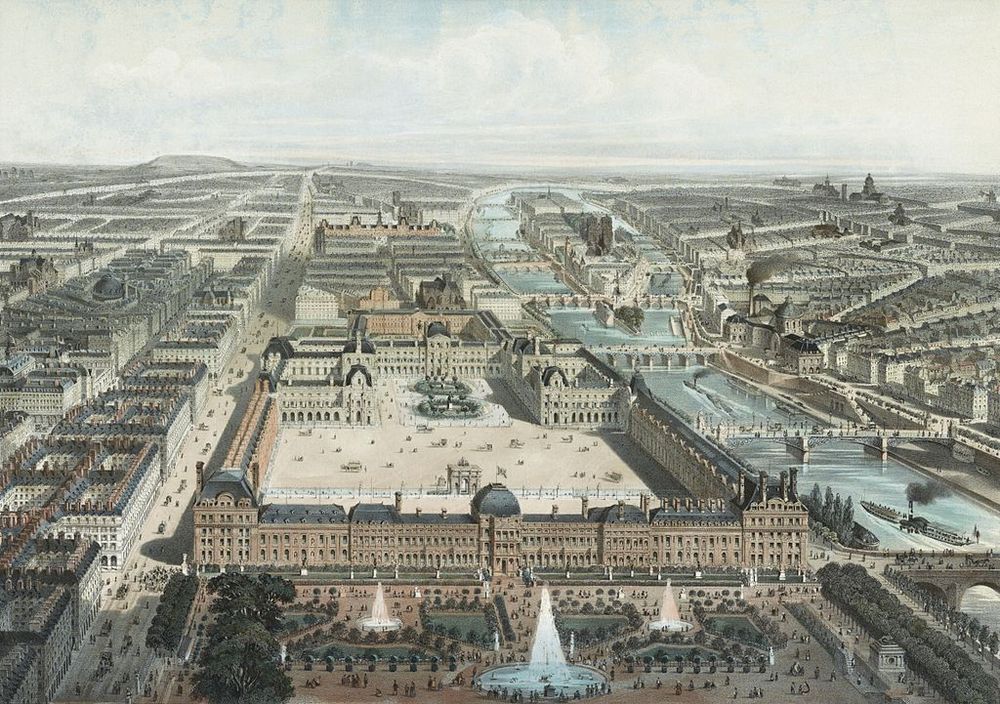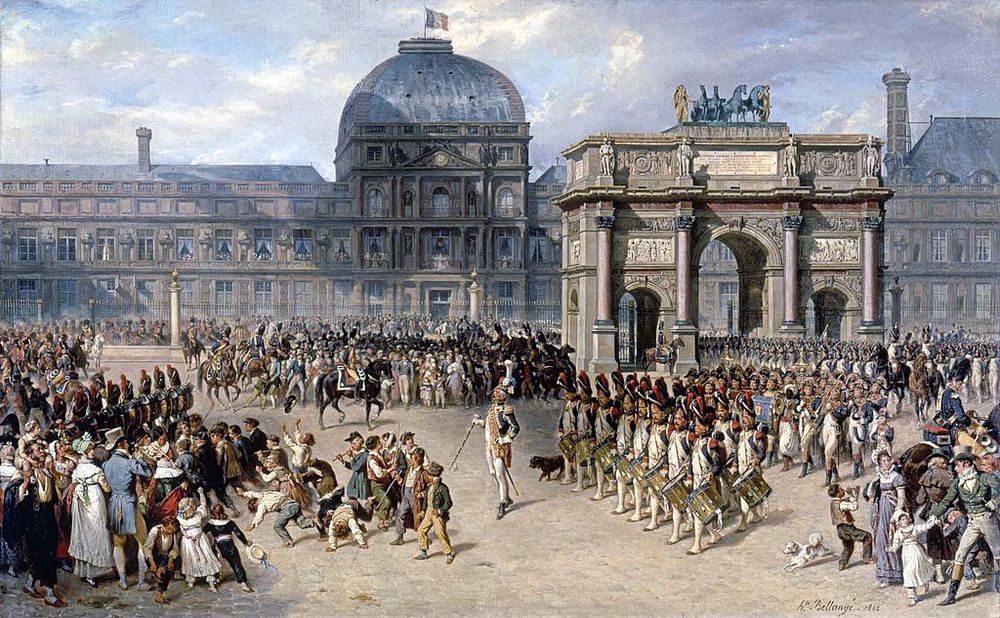Directly in front of the Louvre, between the Arc de Triomphe du Carrousel and the Arc de Triomphe de l'Etoile in Paris, where there is now a vast empty space, there once stood the magnificent Tuileries Palace, home of French monarchs. It was burned down in 1871 by the Paris Commune, a revolutionary government that seized power in Paris for two months.
The Tuileries Palace was commissioned in 1564 by Catherine de' Medici, widow of Henry II of France. After the accidental death of her husband, Catherine wanted a new residence for herself, close to the Louvre. The site selected for the palace, just outside the walls of the city, was previously occupied by the workshops and kilns craftsmen who made "tuiles", or roof tiles, and hence the name of the palace. Catherine engaged Philibert de l'Orme to design the palace. But de l'Orme’s untimely death in 1570 led to Jean Bullant taking his place.
The outbreak of the civil between Protestants and Catholics in Paris in 1588 abruptly halted the work. Work did not resume until 1594, when Henry IV of France made a triumphal return to Paris, and recommenced construction of the Louvre and the Tuileries Palace. He constructed the Grande Galerie, parallel to the Seine, which connected the two palaces. The Grand Gallery and the Gros Pavilion des Tuileries, now called the Pavillon de Flore, was completed during his time.
After the death of Henry IV of France in 1610, work on the palace halted again. It resumed after the civil wars, and between 1659 and 1661, the king and Cardinal Mazarin had First Royal Architect Louis Le Vau enlarge the palace, extending it to the north by the addition of the Théâtre des Tuileries. Le Vau made other significant changes. They transformed Philibert de l'Orme's facades and central pavilion, replacing its grand central staircase with a colonnaded vestibule on the ground floor and the Salle des Cents Suisses on the floor above and adding a rectangular dome. A new grand staircase was installed in the entrance of the north wing of the palace, and lavishly decorated royal apartments were constructed in the south wing. The king's rooms were on the ground floor, facing toward the Louvre, and the queen's on the floor above, overlooking the garden. At the same time, Louis' gardener, André Le Nôtre, redesigned the Tuileries Garden.
The Tuileries, the Louvre and the Rue de Rivoli, view from the Tuileries Gardens.
Military review in front of Napoleon's new triumphal arch in the courtyard (1810).
Despite being built to serve as the king’s residence, Louis XIV spent only a short time there, preferring to settle in the Palace of Versailles instead. Following the death of Louis XIV, his great-grandson and later king, Louis XV, also spent rarely in the Palace. The Tuileries Palace was virtually abandoned and used only as a theatre for operas, concerts and performances of the Comédie-Française.
On December 1, 1783, the palace garden was the starting point of an important event in aviation history, the first manned flight in a hydrogen balloon, by Jacques Charles and the Robert brothers.
In 1791, during the French Revolution, the Tuileries Palace became the forced residence of the King and his family, and the center of French political activity. Then, on 10 August 1792, an armed mob stormed the palace and killed the Swiss Guard, forcing the royal family to flee through the Tuileries garden to find refuge at the Legislative Assembly.
After the Revolution, Napoleon Bonaparte made the Tuileries the center of his imperial power. Under Napoleon, the Tuileries Palace underwent massive architectural changes, and large-scale interior redecoration. Following the defeat and exile of Napoleon, the gardens became a large camp for Russian and Prussian soldiers, while the Kings of France returned to the palace during the Bourbon Restoration. During the July Revolution of 1830, which installed Louis Philippe as the new monarch, the Tuileries was again stormed and occupied by an armed mob.
The Tuileries experienced the most lavish days under Napoleon III. Empress Eugénie held gala dinners, balls and receptions for the crowned heads of Europe.
The wedding of Napoleon III at the Tuileries Palace.
An evening with the Duke of Orleans at the Pavilion de Marsan, Tuileries Palace.
The ambassadors' gallery at the Tuileries Palace.
“Perhaps during the Second Empire, more so that in any other time, the Palais des Tuileries became a primary symbol for opponents of the government,” writes Louis J. Iandoli. He continues:
“The exploitation of the working classes would contrast strikingly with the excesses of the Tuileries: its lavish renovations, the image as a home of aristocratic pleasure and decadence, and the seat of autocratic power. The destruction and demolition of the palace need to be seen in the light of a century-old furor against a building that in the popular imagination became the physical representation of autocrats ... It was the house of rulers ... and as such a fitting symbol for the glories of monarchy and empire. The acrimonious tensions between political forces would lead not just to the burning of the palace, but finally to the symbol's removal from the Parisian landscape, and in many respects from the collective memory of present French society.”
During the Siege of Paris in 1870-71, the a mob of men from the Commune, entered the Tuileries and set fire to the palace using petroleum, liquid tar and turpentine as accelerant. The palace burned for two days and thorougly gutted the place except for the southernmost part. The dome itself was blown up by explosives placed in the central pavilion and detonated by the converging fires. Observing this, Jules Bergeret, the former chief military commander of the Commune, commented: “The last vestiges of Royalty have just disappeared. I wish that the same may befall all the public buildings of Paris.”
The burning of Tuileries Palace on 23 May 1871.
The ruins of the Tuileries stood for 11 years, after which it was demolished. The large empty space between the northern and southern wings of the Louvre, now familiar to modern visitors, was revealed, and for the first time the Louvre courtyard opened onto the unbroken Axe historique.
Today, only the garden remains surrounded by the Louvre (to the east), the Seine (to the south), the Place de la Concorde (to the west) and the Rue de Rivoli (to the north). It still closely follows the design laid out by the royal landscape architect André Le Nôtre in 1664.



















Comments
Post a Comment